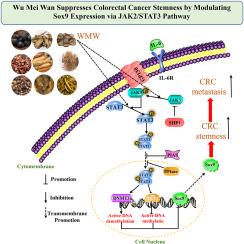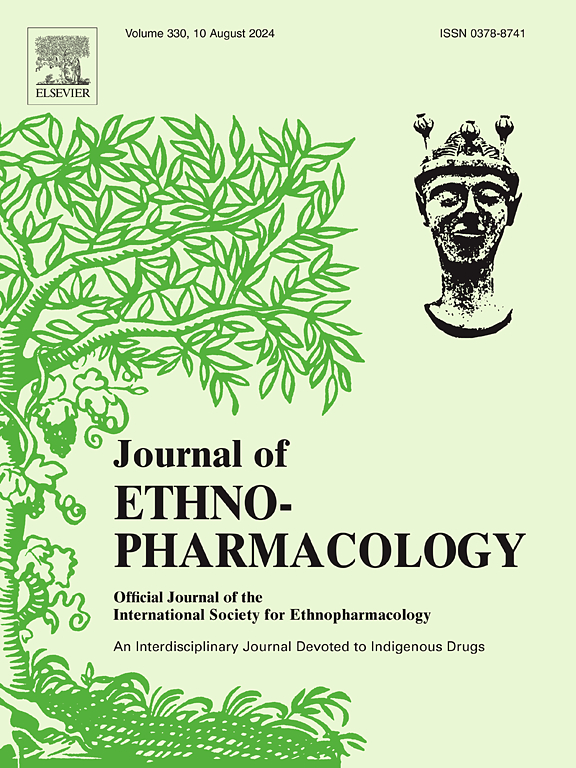Wu Mei Wan suppresses colorectal cancer stemness by regulating Sox9 expression via JAK2/STAT3 pathway
IF 5.4
2区 医学
Q1 CHEMISTRY, MEDICINAL
引用次数: 0
Abstract
Ethnopharmacological relevance
Wu Mei Wan (WMW) is a traditional Chinese herbal formula with a long-standing history in Chinese medicine, valued for its therapeutic properties. However, its potential anti-cancer effects, especially against colorectal cancer (CRC), have not been fully elucidated.
Aim of the study
This study aims to investigate the effects of WMW on colorectal cancer stemness and to elucidate the underlying molecular mechanisms, focusing on the modulation of Sox9 expression via the JAK2/STAT3 signaling pathway.
Materials and methods
WMW was prepared and analyzed using UPLC-MS to identify their main components. To study the therapeutic effects of WMW, AOM/DSS-induced CRC mouse models were established. A comprehensive suite of experimental techniques, including in vivo imaging, cell culture, transfection, CCK-8 assays, colony formation assays, wound healing assays, cell migration assays, Western blotting, dot blot analysis, RT-qPCR, immunohistochemistry, cell transcriptome sequencing, and gene set enrichment analysis, were utilized to explore the pharmacological effects and mechanisms of WMW.
Results
WMW significantly inhibited CRC cell viability, proliferation, invasion, and migration in vitro. Mechanistically, WMW suppressed CRC stemness by downregulating Sox9 expression through the JAK2/STAT3 signaling pathway. Additionally, the regulation of methylation and demethylation mediated by TET1 and DNMT3a expression was directly associated with the JAK2/STAT3 pathway's modulation of Sox9 expression. In vivo, WMW treatment attenuated CRC progression and metastasis with minimal toxicity.
Conclusion
These findings suggest that WMW exerts potent anti-CRC stemness effects by regulating Sox9 via the JAK2/STAT3 signaling pathway, underscoring its potential as a promising therapeutic agent for CRC treatment.

乌梅丸通过 JAK2/STAT3 通路调节 Sox9 的表达抑制结直肠癌干细胞的生长
民族药理学意义:乌梅丸是一种历史悠久的传统中药配方,因其治疗特性而备受重视。然而,其潜在的抗癌作用,尤其是对结肠直肠癌(CRC)的抗癌作用尚未完全阐明:本研究旨在探讨 WMW 对结直肠癌干性的影响,并阐明其潜在的分子机制,重点是通过 JAK2/STAT3 信号通路调节 Sox9 的表达:制备 WMW 并使用 UPLC-MS 分析其主要成分。为了研究 WMW 的治疗效果,建立了 AOM/DSS 诱导的 CRC 小鼠模型。利用体内成像、细胞培养、转染、CCK-8检测、集落形成检测、伤口愈合检测、细胞迁移检测、Western印迹、点印迹分析、RT-qPCR、免疫组化、细胞转录组测序和基因组富集分析等一整套实验技术来探讨WMW的药理作用和机制:结果:WMW能明显抑制体外CRC细胞的活力、增殖、侵袭和迁移。从机理上讲,WMW通过JAK2/STAT3信号通路下调Sox9的表达,从而抑制了CRC干性。此外,由TET1和DNMT3a表达介导的甲基化和去甲基化调控与JAK2/STAT3通路对Sox9表达的调控直接相关。在体内,WMW治疗可减轻CRC的进展和转移,且毒性极低:这些研究结果表明,WMW通过JAK2/STAT3信号通路调节Sox9,从而发挥了强大的抗CRC干细胞作用,突出了其作为CRC治疗药物的潜力。
本文章由计算机程序翻译,如有差异,请以英文原文为准。
求助全文
约1分钟内获得全文
求助全文
来源期刊

Journal of ethnopharmacology
医学-全科医学与补充医学
CiteScore
10.30
自引率
5.60%
发文量
967
审稿时长
77 days
期刊介绍:
The Journal of Ethnopharmacology is dedicated to the exchange of information and understandings about people''s use of plants, fungi, animals, microorganisms and minerals and their biological and pharmacological effects based on the principles established through international conventions. Early people confronted with illness and disease, discovered a wealth of useful therapeutic agents in the plant and animal kingdoms. The empirical knowledge of these medicinal substances and their toxic potential was passed on by oral tradition and sometimes recorded in herbals and other texts on materia medica. Many valuable drugs of today (e.g., atropine, ephedrine, tubocurarine, digoxin, reserpine) came into use through the study of indigenous remedies. Chemists continue to use plant-derived drugs (e.g., morphine, taxol, physostigmine, quinidine, emetine) as prototypes in their attempts to develop more effective and less toxic medicinals.
 求助内容:
求助内容: 应助结果提醒方式:
应助结果提醒方式:


